


Kathleen Meyer
Kathleen Meyer
4th Edition!!!



Feel free to address prickly problems, toss out new ideas, comment with candor on products and locations, regale success stories, network with fervor, and—above all—dream up backcountry sanitation that achieves the ultimate in ecological and aesthetic preservation of those precious places in our shrinking wild.
Shooting the Shit will post in a relaxed fashion, leaving us all time for rivers, mountains, oceans, and that old thing “making a living.” I realize that anything snail-like these days is bucking the trend but the offbeat path, now and again, screams to be followed. How I know it!



“Save me!”
It was the early 1970s, when I first learned the earth’s temperature was warming and I had no idea that anything as disastrous as what the world now faces would occur, let alone in my lifetime. Surely something not to worry about. Many years would pass before I understood it was directly tied to the industrial revolution caused largely by societies of the global north.
Late in that same 70s decade, a friend of mine chained himself to bedrock in a river canyon to stop—he hoped, he was not suicidal—the rising water behind a dam that would significantly become the final mega structure in an era of fading, out-of-date dam-building. Just this week, more than 40 years later, I had occasion over the phone to hear about a “species party” that went on during what he nowadays calls his “camping trip.” For this ever-in-motion 6’8’’ man, suddenly constrained by a six-inch steel leash and scrunched beneath a boulder’s overhang, life changed, as his heart grew yet bigger. All was quiet, all was still. The first day a lizard appeared on a nearby rock, And then, it came everyday. On the third day, a close-by rustling rose to his awareness. He focused and a wee shrew poked out its head. Soon he was tuning in the daily schedules of other species—otters playing, beavers busy on beaver missions. Because he had become no more than part of the scenery, one afternoon a snake, 3–4 inches in diameter, which he at first nervously took to be a rattler, pressed against him as it slithered blithely along its way. His species party serves as a clear picture for me of all the creatures, not just human, in today’s paths of worsening wildfires, tornadoes, hurricanes, downpours, floods, landslides, droughts, parched fields.
Which brings me to where my thoughts are today.
Is it not long past time that we of the global north joined together in dropping the idea of human superiority and instead conceded that, upon this precious home Earth, we are no more important than a puddle of mud, a pinch of gravel, a rock. That the susurration of leaves overhead, the wetness in rivulets of rain, the scent of summer-blooming jasmine; whales, fleas, elephants, house cats; globs of refrigerator mold, aerosol whiffs of skunk, hissing Madagascar cockroaches; granite, sand, mice, and sewer rats are all our matrilineal (same mother) siblings, or our elders.
Our endless conquering handiwork and peculiar economic vision of “progress,” our ever-rabid consumption surrounding narcissistic convenience, comfort, and greed have ripped loose this planet’s well-moored, millennial-steady underpinnings. All signs, signals, science, and local weather say we’re living in a gone-sick world where the wondrous complex nature of wind and water, of long evolved systems of sun, soil, and life are flapping around disastrously unhinged. For fifty years, inklings at first, then PhD’s of awareness, have screamed into a nearly deaf void.
God, I’m fairly certain, won’t save us. Any higher power sees a larger picture here than a bunch of humans pissing off Mother Nature. The planet will carry on, in orbit, just not as we have know and loved it.
An aside: At the tender age of seven, I parted with God—as conceptualized by any organized, ornately-housed religion—in Sunday school, upon receiving a stupefying F-grade. Had I known the F-word then, it would have sped across my lips riding a hot wind. What the hey, I was an A-student five days a week. When twenty-five and wearing jeans, at a mountaintop sunrise service, I lurched toward the divine pagan in nurturing the notion that worship and communion were meant, like a walk in the woods, to take place outdoors. Eventually past forty, I fell into the Blackfeet way, with its inclusiveness, one-with-all; its sacred closeness with our cherished Mother’s worth; its elevation of honoring, gratitude, respect, humility, and investment in community. Plunked right on the ground, I could sit and sing amid my surrounding relatives and commune with the Great Mystery.
humans I want to step right into this photo and settle down on the seat—no flushing racket here, no bowl cleaning, no plumbing disasters—nothing but tranquility and magnificence for meditating on the divine worth of our Mother Earth. A “place of easement,” as the Elizabethans called it. A D-Can, as Canyon REO calls it.
Now the disturbing news. With Covid’s arrival last year, virus-avoiders began discovering th
D-Can
For those organizing a private river trip through the Grand Canyon, or a trip on the San Juan River or Salt River, check out Canyon REO (River Equipment Outfitters)—www.canyonreo.com—as a source for both rentals and sales of river rafting gear. They specialize in private-trip rental equipment. Shown above is their D-Can carry-out toilet system. Find its description below, a combined excerpt from the 4th edition of How to Shit in the Woods (gathered from pages 50 and 53, and the intro paragraphs to washable-reusable carry-out systems).
But let’s talk about the D-Can rental! For $3.00 per day it includes the D-Can with seat assembly and the 20 mm can needed for storage while on the water and a “day toilet”—National Park Service required—consisting of a 50 caliber ammo can with kitty litter. A Wishy-Washy Hand Washer station rents for an additional $35 per trip. “But here’s the best: for a measly $30, at the end of your trip, you’re allowed to return a chock-full can to Canyon REO, twirl on your heel and waltz away.”
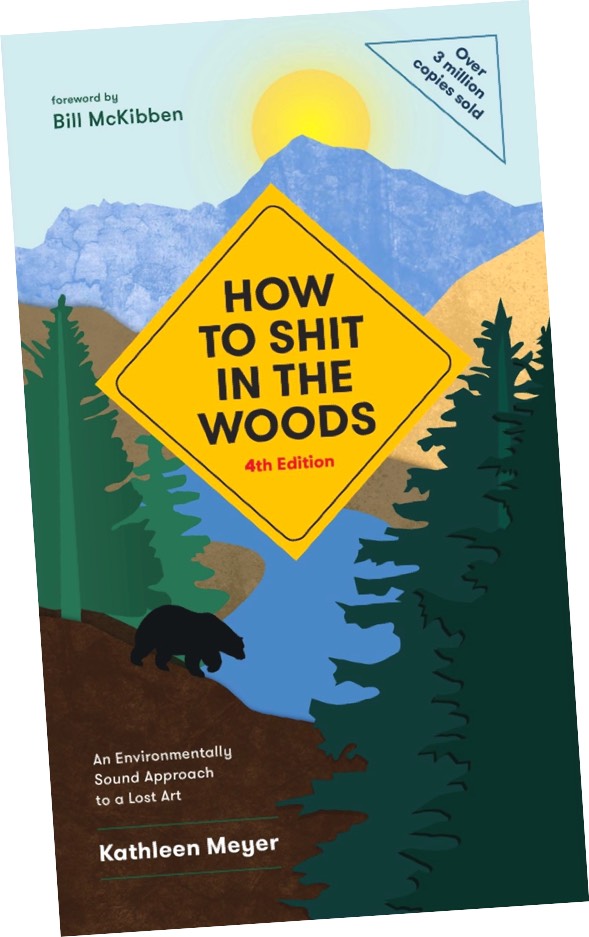
“Kathleen Meyer is a treasure: In these days of disappearing wilderness and an unlivable hot earth, I can’t imagine a more trusted guide for the woods and the wild.”
—Doug Peacock, world’s most tenacious protector of grizzly bears, author of Walking It Off: A Veteran’s Chronicle of War and Wilderness.
“As a philosophy of life built on the profound interconnection between self and nature, How to Shit in the Woods is clearly the definitive text on the subject.”
—Gail D. Storey, author of the award-winning outdoor
memoir I Promise Not to Suffer: A Fool for Love
Hikes the Pacific Crest Trail
“Read it as a guide but also as a metaphor . . . immensely
practical, in deep and powerful ways.” [Taken from the foreword.]
—Bill McKibben, author and activist and founder of 350.0rg,
the international climate crisis organization. His latest
book is Falter: Has the Human Game Begun
to Play Itself Out?
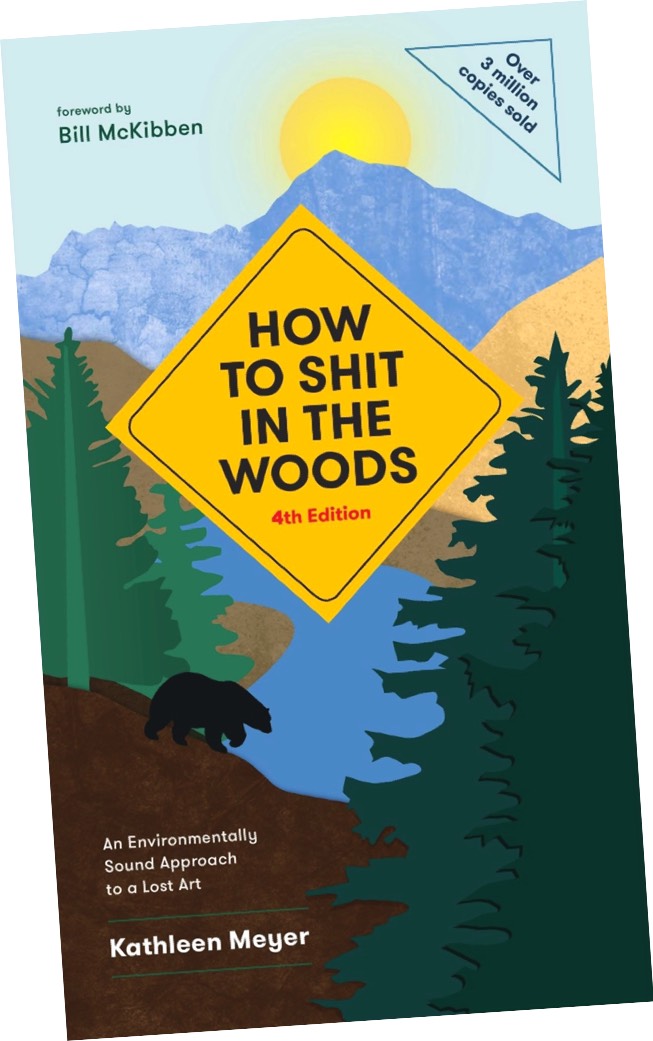
“Kathleen Meyer is a treasure: In these days of disappearing wilderness and an unlivable hot earth, I can’t imagine a more trusted guide for the woods and the wild.”
—Doug Peacock, author of Walking
It Off: A Veteran’s Chronicle of
War and Wilderness,
and so many more.
“As a philosophy of life built on the profound interconnection between self and nature, How to Shit in the Woods is clearly the definitive text on the subject.”
—Gail D. Storey, author of the
award-winning outdoor memoir
I PromiseNot to Suffer: A
Fool for Love Hikes the
Pacific Crest Trail
“Read it as a guide but also as a metaphor . . . immensely practical, in deep and powerful ways.” [Taken from the foreword.]
—Bill McKibben, author and activist
and founder of 350.0rg, the
international climate crisis
organization. His latest
book is Falter:Has the
Human Game Begun
to Play Itself Out?
No kidding. See the article in the July High Country News, p. 16, Public Lands Inundated. “Human waste and toilet paper . . . alongside photogenic lakes and streams.” Shocking article. Let’s get on it.
Ugh! Let’s do!
Hey, Kathleen, wonderful praise, and so true! I’ll be on the phone, right off. Teach everybody!
Yes, wonderful! I’m deeply, humbly grateful.
Calling all dendrophiles! After this last year of challenges in the emotional, physical, and spiritual realms, your book is a rallying call (once again) to get out into nature and reboot oneself! The Great Mother is calling those with the ears, eyes, and hearts, and respect for her most sacred places. Remember, SHE has the last word and does not take any “sh*t” in any way, shape, or form. Pardon the pun, Kathleen! Onward always!
Gooo good woman, and dear TreeSister! No prob—my kind of pun!
I’m grateful for this handy, updated, and important guide that improves the quality of our backcountry experiences. Thanks, Kathleen.
My gratitude is for your sisterly support and long friendship. We need to plan a watery trip!

What a sweet site, sight, and delight!
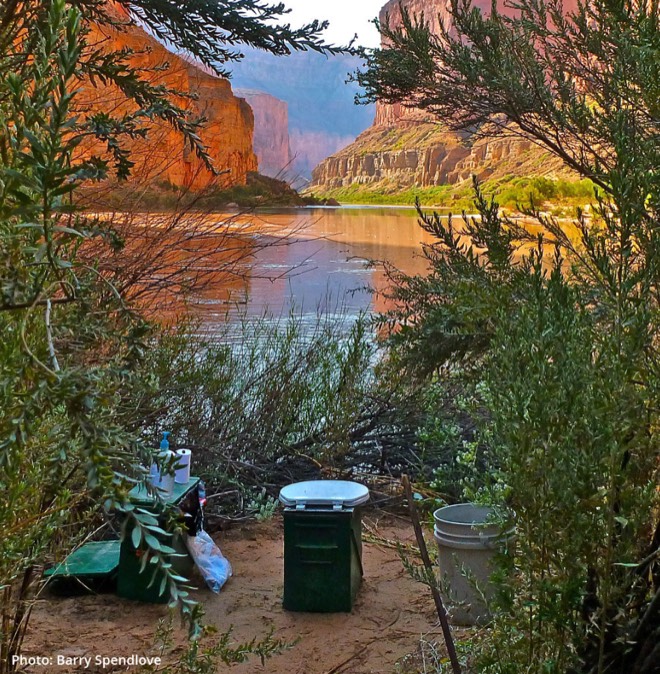
Photo is from Canyon REO’s website
Now the disturbing news. With Covid’s arrival, virus-avoiders searching for fresh air began to discover the grandeur of Nature. Right off, here in Montana, our downtown streets and sidewalks were positively empty, while trailhead parking lots overflowed. Sauntering into the mountains, seeking serenity, felt more like hitting LA freeways at rush hour. THEN, THE PROBLEM AROSE. Newcomers, by the hordes, became hooked on Nature’s beauty, while remaining unschooled in the basics of sanitation protocol and the outback etiquette of “leave only foot prints.” All manner of our precious wild places—mountain trails, backcountry campsites, lakesides, river banks—are under assault by an inordinate amount of toilet trash: blights of blowing baby wipes, half-buried toilet paper, and raw piles of poop.
My suggestion—an idea easier, wiser, and less expensive than instituting strict regulations enforced by a potty patrol—is a little “wild” promotion of the newest edition of my guidebook. You’ll find it thoroughly revised, with a foreword by renowned author and climate activist Bill McKibben. Every backcountry newbie needs a copy of How to Shit in the Woods: An Environmentally Sound Approach to a Lost Art!
Please join me in doing all that we can to encourage others to respect and protect these sacred places. Contact your local independent bookstores and outdoor stores, to share the growing problem and inquire as to whether they’re carrying/showcasing! this best-selling guidebook: How to Shit in the Woods? And . . . if not, would they please!
D-Can
For those organizing a private river trip through the Grand Canyon, or a trip on the San Juan River or Salt River, check out Canyon REO (River Equipment Outfitters)—www.canyonreo.com—as a source for both rentals and sales of river rafting gear. They specialize in private-trip rental equipment. Shown above is their D-Can carry-out toilet system. Find its description below, a combined excerpt from the 4th edition of How to Shit in the Woods (gathered from pages 50 and 53, and the intro paragraphs to washable-reusable carry-out systems).
But let’s talk about the D-Can rental! For $3.00 per day it includes the D-Can with seat assembly and the 20 mm can needed for storage while on the water and a “day toilet”—National Park Service required—consisting of a 50 caliber ammo can with kitty litter. A Wishy-Washy Hand Washer station rents for an additional $35 per trip. “But here’s the best: for a measly $30, at the end of your trip, you’re allowed to return a chock-full can to Canyon REO, twirl on your heel and waltz away.”
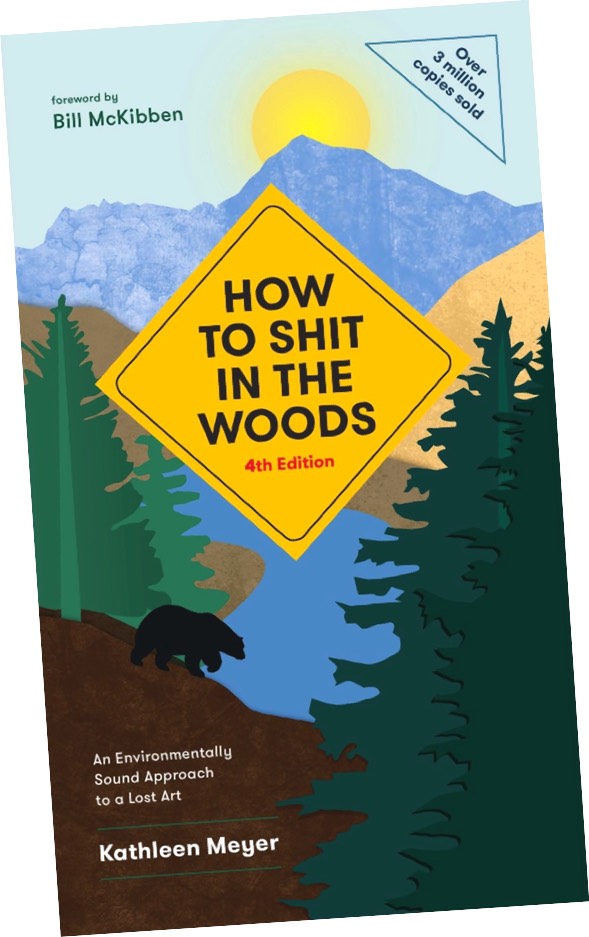
“Kathleen Meyer is a treasure: In these days of disappearing wilderness and an unlivable hot earth, I can’t imagine a more trusted guide for the woods and the wild.”
—Doug Peacock, world’s most tenacious protector of grizzly bears, author of Walking It Off: A Veteran’s Chronicle of War and Wilderness.
“As a philosophy of life built on the profound interconnection between self and nature, How to Shit in the Woods is clearly the definitive text on the subject.”
—Gail D. Storey, author of the award-winning outdoor
memoir I Promise Not to Suffer: A Fool for Love
Hikes the Pacific Crest Trail
“Read it as a guide but also as a metaphor . . . immensely
practical, in deep and powerful ways.” [Taken from the foreword.]
—Bill McKibben, author and activist and founder of 350.0rg,
the international climate crisis organization. His latest
book is Falter: Has the Human Game Begun
to Play Itself Out?
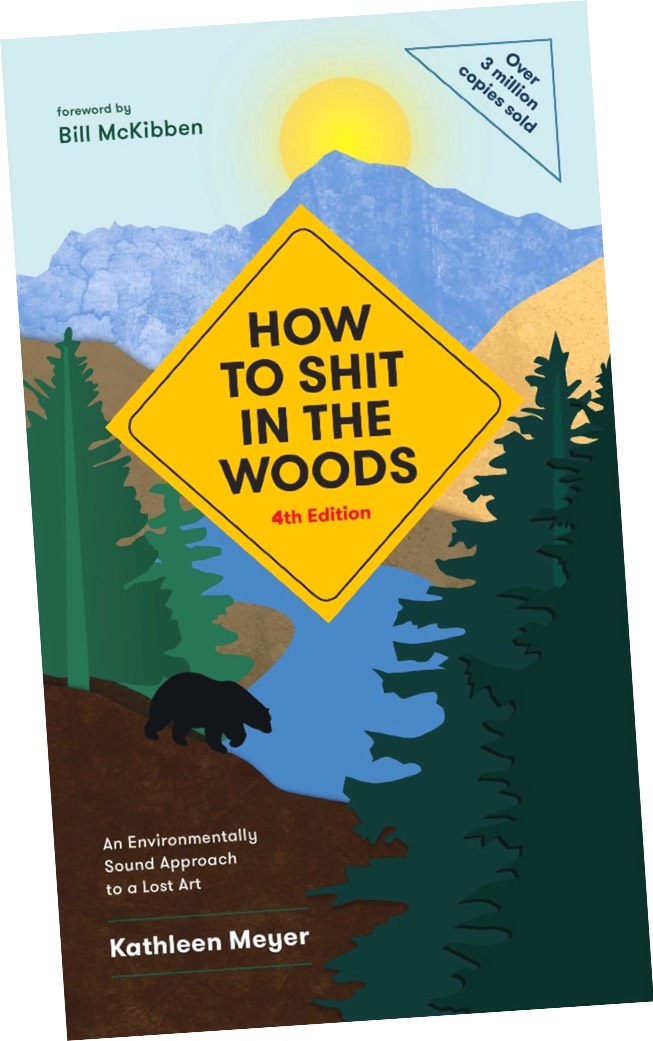
“Kathleen Meyer is a treasure: In these days of disappearing wilderness and an unlivable hot earth, I can’t imagine a more trusted guide for the woods and the wild.”
—Doug Peacock, author of Walking
It Off: A Veteran’s Chronicle of
War and Wilderness,
and so many more.
“As a philosophy of life built on the profound interconnection between self and nature, How to Shit in the Woods is clearly the definitive text on the subject.”
—Gail D. Storey, author of the
award-winning outdoor memoir
I PromiseNot to Suffer: A
Fool for Love Hikes the
Pacific Crest Trail
“Read it as a guide but also as a metaphor . . . immensely practical, in deep and powerful ways.” [Taken from the foreword.]
—Bill McKibben, author and activist
and founder of 350.0rg, the
international climate crisis
organization. His latest
book is Falter:Has the
Human Game Begun
to Play Itself Out?
No kidding. See the article in the July High Country News, p. 16, Public Lands Inundated. “Human waste and toilet paper . . . alongside photogenic lakes and streams.” Shocking article. Let’s get on it.
Ugh! Let’s do!
Hey, Kathleen, wonderful praise, and so true! I’ll be on the phone, right off. Teach everybody!
Yes, wonderful! I’m deeply, humbly grateful.
Calling all dendrophiles! After this last year of challenges in the emotional, physical, and spiritual realms, your book is a rallying call (once again) to get out into nature and reboot oneself! The Great Mother is calling those with the ears, eyes, and hearts, and respect for her most sacred places. Remember, SHE has the last word and does not take any “sh*t” in any way, shape, or form. Pardon the pun, Kathleen! Onward always!
Gooo good woman, and dear TreeSister! No prob—my kind of pun!
I’m grateful for this handy, updated, and important guide that improves the quality of our backcountry experiences. Thanks, Kathleen.
My gratitude is for your sisterly support and long friendship. We need to plan a watery trip!

What a sweet site, sight, and delight!

Photo from Canyon REO’s website
Now the disturbing news. With Covid’s arrival, virus-avoiders searching for fresh air began to discover the grandeur of Nature. Right off, here in Montana, our downtown streets and sidewalks were positively empty, while trailhead parking lots overflowed. Sauntering into the mountains, seeking serenity, felt more like hitting LA freeways at rush hour. THEN, THE PROBLEM AROSE. Newcomers, by the hordes, became hooked on Nature’s beauty, while remaining unschooled in the basics of sanitation protocol and the outback etiquette of “leave only foot prints.” All manner of our precious wild places—mountain trails, backcountry campsites, lakesides, river banks—are under assault by an inordinate amount of toilet trash: blights of blowing baby wipes, half-buried toilet paper, and raw piles of poop.
My suggestion—an idea easier, wiser, and less expensive than instituting strict regulations enforced by a potty patrol—is a little “wild” promotion of the newest edition of my guidebook. You’ll find it thoroughly revised, with a foreword by renowned author and climate activist Bill McKibben. Every backcountry newbie needs a copy of How to Shit in the Woods: An Environmentally Sound Approach to a Lost Art!
Please join me in doing all that we can to encourage others to respect and protect these sacred places. Contact your local independent bookstores and outdoor stores, to share the growing problem and inquire as to whether they’re carrying/showcasing! this best-selling guidebook: How to Shit in the Woods? And . . . if not, would they please!
D-Can
Organizing a private river trip through the Grand Canyon, or a trip on the San Juan River or Salt River? Check out Canyon REO (River Equipment Outfitters)—www.canyonreo.com—a source for both rentals and sales of river rafting gear. They specialize in private-trip rental equipment. Shown above is their D-Can carry-out toilet system. Find its description below, a combined excerpt from the 4th edition of How to Shit in the Woods (gathered from pages 50 and 53, and the intro paragraphs to washable-reusable carry-out systems).
But let’s talk about the D-Can rental! For $3.00 per day it includes the D-Can with seat assembly and the 20 mm can needed for storage while on the water and a “day toilet”—National Park Service required—consisting of a 50 caliber ammo can with kitty litter. A Wishy-Washy Hand Washer station rents for an additional $35 per trip. But here’s the best: for a measly $30, at the end of your trip, you’re allowed to return a chock-full can to Canyon REO, twirl on your heel and waltz away.

“Kathleen Meyer is a treasure: In these days of disappearing wilderness and an unlivable hot earth, I can’t imagine a more trusted guide for the woods and the wild.”
—Doug Peacock, author of Walking
It Off: A Veteran’s Chronicle of
War and Wilderness,
and so many more.
“As a philosophy of life built on the profound interconnection between self and nature, How to Shit in the Woods is clearly the definitive text on the subject.”
—Gail D. Storey, author of the
award-winning outdoor memoir
I PromiseNot to Suffer: A
Fool for Love Hikes the
Pacific Crest Trail
“Read it as a guide but also as a metaphor . . . immensely practical, in deep and powerful ways.” [Taken from the foreword.]
—Bill McKibben, author and activist
and founder of 350.0rg, the
international climate crisis
organization. His latest
book is Falter:Has the
Human Game Begun
to Play Itself Out?
No kidding. Mentioned in the article in the July High Country News, p. 16, Public Lands Inundated. “Human waste and toilet paper . . . alongside photogenic lakes and streams.” Shocking article. Let’s get on it.
Ugh! Let’s do!
Hey, Kathleen, wonderful praise, and so true! I’ll be on the phone, right off. Teach everybody!
Yes, wonderful! I’m deeply, humbly grateful.
Calling all dendrophiles! After this last year of challenges in the emotional, physical, and spiritual realms, your book is a rallying call (once again) to get out into nature and reboot oneself! The Great Mother is calling those with the ears, eyes, and hearts, and respect for her most sacred places. Remember, SHE has the last word and does not take any “sh*t” in any way, shape, or form. Pardon the pun, Kathleen! Onward always!
Gooo good woman, and dear TreeSister! No prob—my kind of pun!
I’m grateful for this handy, updated, and important guide that improves the quality of our backcountry experiences. Thanks, Kathleen.
My gratitude is for your sisterly support and long friendship. We need to plan a watery trip!

A Blast From The Past
“The Voice of a River” is his story in a ten-minute video—put together for Earth Day by My Green Pod in the UK. As a young river rat, Mark DuBois, internalized immense “connection” and love for the natural treasures of the Stanislaus River canyon, enough to put his life on the line for its survival. Though over the long haul, it was adopting a rudimentary process of “learn-as-you-go” . . . through brutal defeats and joyful uplifts, which together served to transform his voice into an intent, effective, and enduring protector—expanding eventually to worldwide rivers and the planet. Inspiration and empowerment for everyone! wanting to developed the strength and courage to continue.
Link to “Voice of a River,” partially narrated by Mark’s wife Clare, founder of TreeSisters: https://www.youtube.com/watch?v=OQkEC08nTI8
Sacred river blessings upon you, Mark.
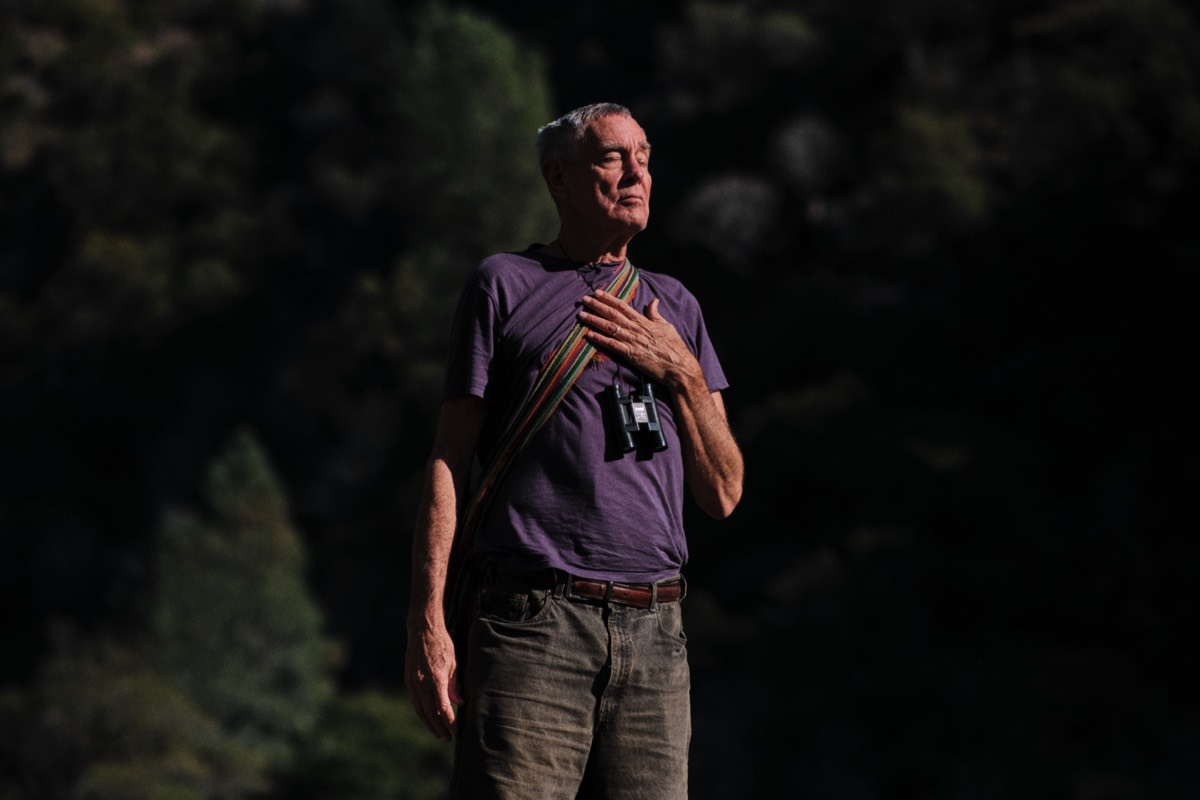
Mark Dubois
TreeSisters, global reforestation.
A Blast From The Past
“The Voice of a River” is his story in a ten-minute video—put together for Earth Day by My Green Pod in the UK. As a young river rat, Mark DuBois, internalized immense “connection” and love for the natural treasures of the Stanislaus River canyon, enough to put his life on the line for its survival. Though over the long haul, it was adopting a rudimentary process of “learn-as-you-go” . . . through brutal defeats and joyful uplifts, which together served to transform his voice into an intent, effective, and enduring protector—expanding eventually to worldwide rivers and the planet. Inspiration and empowerment for everyone! wanting to developed the strength and courage to continue.
Link to “Voice of a River,” partially narrated by Mark’s wife Clare, founder of TreeSisters: https://www.youtube.com/watch?v=OQkEC08nTI8
Sacred river blessings upon you, Mark.

TreeSisters, global reforestation.
Oh how this has taken me back to earlier (and wilder!) days. Many spent on the Stanislaus, three forks of it, and rivers south and north. It was my first adventure to CA right out of high school in 1972, full of energy, wide eyed and ready for whatever came my way. Never met Mark, however, we would have been kindred spirits for sure! What a beautiful, beautiful river! Thank you Kathleen for the looking glass into the past . . .
We must have just slid or paddled past each other. Sooo happy to have eventually crossed paths with a dear river sister.
That video is fabulous! I cried all the way through. I was devastated to see the before and after footage of the Stanislaus River. It felt like losing a piece of my heart.
Oh, Liz . . . and this from someone who never saw the river, swam its waters, crawled all over its terrain and caves. Astoundingly, there were many in the 70s who worked tirelessly to save it without having touch it. The river somehow touched them from afar.
I had no idea, before my time. Sending huge gratitude to Mark, for his choosing such a life. And to those who followed, and will follow. An aha moment of creative insight for when we stand tall, roll, paddle, gather, and persist in preservation and restoration. Thanks to My Green Pod and Kathleen for posting this.
Oh, Wild—you got it! Onward we go . . .

What a sweet site, sight, and delight!

Photo from Canyon REO’s website
Now the disturbing news. With Covid’s arrival, virus-avoiders searching for fresh air began to discover the grandeur of Nature. Right off, here in Montana, our downtown streets and sidewalks were positively empty, while trailhead parking lots overflowed. Sauntering into the mountains, seeking serenity, felt more like hitting LA freeways at rush hour. THEN, THE PROBLEM AROSE. Newcomers, by the hordes, became hooked on Nature’s beauty, while remaining unschooled in the basics of sanitation protocol and the outback etiquette of “leave only foot prints.” All manner of our precious wild places—mountain trails, backcountry campsites, lakesides, river banks—are under assault by an inordinate amount of toilet trash: blights of blowing baby wipes, half-buried toilet paper, and raw piles of poop.
My suggestion—an idea easier, wiser, and less expensive than instituting strict regulations enforced by a potty patrol—is a little “wild” promotion of the newest edition of my guidebook. You’ll find it thoroughly revised, with a foreword by renowned author and climate activist Bill McKibben. Every backcountry newbie needs a copy of How to Shit in the Woods: An Environmentally Sound Approach to a Lost Art!
Please join me in doing all that we can to encourage others to respect and protect these sacred places. Contact your local independent bookstores and outdoor stores, to share the growing problem and inquire as to whether they’re carrying/showcasing! this best-selling guidebook: How to Shit in the Woods? And . . . if not, would they please!
D-Can
Organizing a private river trip through the Grand Canyon, or a trip on the San Juan River or Salt River? Check out Canyon REO (River Equipment Outfitters)—www.canyonreo.com—a source for both rentals and sales of river rafting gear. They specialize in private-trip rental equipment. Shown above is their D-Can carry-out toilet system. Find its description below, a combined excerpt from the 4th edition of How to Shit in the Woods (gathered from pages 50 and 53, and the intro paragraphs to washable-reusable carry-out systems).
But let’s talk about the D-Can rental! For $3.00 per day it includes the D-Can with seat assembly and the 20 mm can needed for storage while on the water and a “day toilet”—National Park Service required—consisting of a 50 caliber ammo can with kitty litter. A Wishy-Washy Hand Washer station rents for an additional $35 per trip. But here’s the best: for a measly $30, at the end of your trip, you’re allowed to return a chock-full can to Canyon REO, twirl on your heel and waltz away.
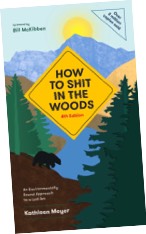
“Kathleen Meyer is a treasure: In these days of disappearing wilderness and an unlivable hot earth, I can’t imagine a more trusted guide for the woods and the wild.”
—Doug Peacock, author of Walking
It Off: A Veteran’s Chronicle of
War and Wilderness,
and so many more.
“As a philosophy of life built on the profound interconnection between self and nature, How to Shit in the Woods is clearly the definitive text on the subject.”
—Gail D. Storey, author of the
award-winning outdoor memoir
I PromiseNot to Suffer: A
Fool for Love Hikes the
Pacific Crest Trail
“Read it as a guide but also as a metaphor . . . immensely practical, in deep and powerful ways.” [Taken from the foreword.]
—Bill McKibben, author and activist
and founder of 350.0rg, the
international climate crisis
organization. His latest
book is Falter:Has the
Human Game Begun
to Play Itself Out?
* * *
No kidding. Mentioned in the article in the July High Country News, p. 16, Public Lands Inundated. “Human waste and toilet paper . . . alongside photogenic lakes and streams.” Shocking article. Let’s get on it.
Ugh! Let’s do!
Hey, Kathleen, wonderful praise, and so true! I’ll be on the phone, right off. Teach everybody!
Yes, wonderful! I’m deeply, humbly grateful.
Calling all dendrophiles! After this last year of challenges in the emotional, physical, and spiritual realms, your book is a rallying call (once again) to get out into nature and reboot oneself! The Great Mother is calling those with the ears, eyes, and hearts, and respect for her most sacred places. Remember, SHE has the last word and does not take any “sh*t” in any way, shape, or form. Pardon the pun, Kathleen! Onward always!
Gooo good woman, and dear TreeSister! No prob—my kind of pun!
I’m grateful for this handy, updated, and important guide that improves the quality of our backcountry experiences. Thanks, Kathleen.
My gratitude is for your sisterly support and long friendship. We need to plan a watery trip!

Masthead photo: “Sunrise over Sea of Cortez,” by James “Diego” Hatfield
© 2011 by Author Kathleen Meyer • All Rights Reserved
Website design by RapidRiver.us
Masthead photo: “Sunrise over Sea of Cortez,”
by James “Diego” Hatfield
_____________
© 2011 by Author Kathleen Meyer • All Rights Reserved
Website design by RapidRiver.us




